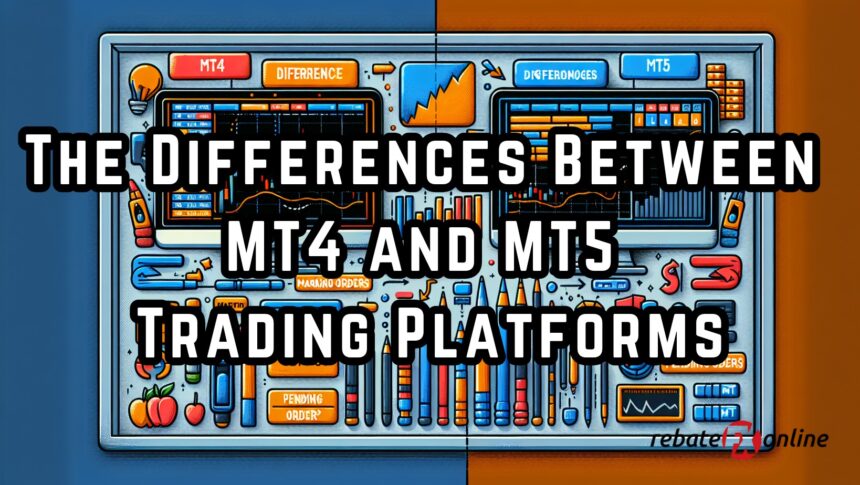MetaTrader 4 (MT4) and MetaTrader 5 (MT5) are two of the most popular trading platforms used by forex traders around the world. Developed by MetaQuotes Software, these platforms offer robust features and tools for trading, but they also have distinct differences. Understanding these differences is crucial for traders to choose the platform that best suits their trading style and needs. Here’s a comprehensive look at the key differences between MT4 and MT5.
1. Release and Market Focus
- MT4: Released in 2005, MT4 was primarily designed for forex trading. It quickly became the industry standard due to its user-friendly interface and powerful trading capabilities.
- MT5: Launched in 2010, MT5 is an upgraded version of MT4, offering a broader range of trading instruments. While it supports forex trading, it also includes futures, stocks, and CFDs, making it a multi-asset trading platform.
2. Technical Analysis Tools
- MT4: MT4 provides 30 built-in technical indicators and 9 timeframes, which are sufficient for most forex traders. The platform also supports custom indicators, enabling traders to expand their analysis tools.
- MT5: MT5 expands on MT4’s offerings with 38 built-in technical indicators and 21 timeframes. It also includes additional charting tools, such as more graphical objects, enhancing the depth and precision of technical analysis.
3. Order Types and Execution Modes
- MT4: MT4 supports four types of pending orders: Buy Limit, Sell Limit, Buy Stop, and Sell Stop. It offers three execution modes: Instant Execution, Request Execution, and Market Execution.
- MT5: MT5 introduces two additional pending orders: Buy Stop Limit and Sell Stop Limit, totaling six. It also supports four execution modes: Instant, Request, Market, and Exchange Execution. These additional order types and execution modes provide traders with greater flexibility and control over their trades.
4. Trading Strategy and Automation
- MT4: The platform features the MQL4 programming language, which allows traders to create custom indicators, scripts, and automated trading strategies known as Expert Advisors (EAs). MT4’s ecosystem of EAs is well-developed, with many available in the market.
- MT5: MT5 uses the MQL5 programming language, which is more advanced and allows for more complex trading algorithms and features. The MQL5 language is faster and supports object-oriented programming, which can improve the efficiency of automated trading strategies.
5. Fundamental Analysis Tools
- MT4: MT4 includes a limited set of fundamental analysis tools. It offers basic news feeds and economic calendars to help traders make informed decisions.
- MT5: MT5 provides enhanced fundamental analysis tools, including an integrated economic calendar, financial news, and depth of market (DOM) data. These features help traders analyze market conditions more comprehensively.
6. Hedging and Netting
- MT4: MT4 supports hedging, allowing traders to open multiple positions in the same market, either in the same or opposite directions.
- MT5: MT5 supports both hedging and netting. Netting is often used in exchange-traded markets, where positions in the same instrument are consolidated. This flexibility makes MT5 suitable for a wider range of trading strategies.
7. User Interface and Experience
- MT4: Known for its simplicity and ease of use, MT4’s interface is highly intuitive, which has contributed to its popularity among forex traders.
- MT5: MT5’s interface is more modern and sophisticated, with additional features and tools that might appeal to advanced traders. However, this also means it has a steeper learning curve compared to MT4.
8. Market Depth and Time & Sales
- MT4: MT4 does not offer Market Depth (DOM) or Time & Sales features, which limits visibility into the order flow.
- MT5: MT5 includes Market Depth and Time & Sales data, providing traders with greater insight into market liquidity and order flow, which can be crucial for more sophisticated trading strategies.
9. Community and Marketplace
- MT4: With its longer history, MT4 has a vast community of users and a well-established marketplace for EAs, indicators, and other trading tools.
- MT5: While MT5’s community and marketplace are growing, they are not as extensive as those of MT4. However, the integration of more advanced features in MT5 is attracting a growing number of traders.
Conclusion
Both MT4 and MT5 offer powerful tools and features for traders, but they cater to different needs. MT4 remains the preferred choice for many forex traders due to its simplicity, ease of use, and established community. On the other hand, MT5 provides advanced features, a broader range of trading instruments, and superior analytical tools, making it suitable for traders who require a more versatile platform. Ultimately, the choice between MT4 and MT5 depends on individual trading preferences and requirements.

